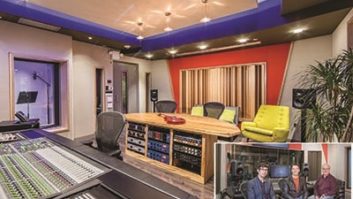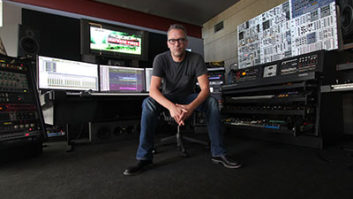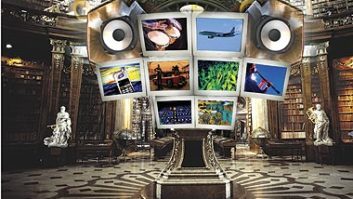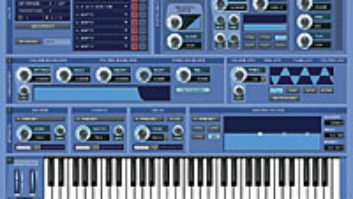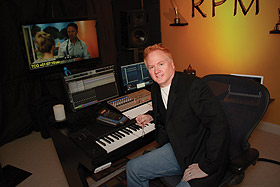
Take the time machine back just a few years—to 2005, say, or 2006—and you will see that the model that composers working to picture followed was fairly universal. Their DAWs might differ, with Mac the preferred sequencer platform for most. Some worked on PCs, but most composers had multiple computers (up to a half-dozen or more) networked together. Limitations in speed, RAM and hard disk size made it impossible for them to produce scores under the time pressures that the industry imposed using only one or two computers.
Not that it was impossible to execute large orchestral tracks on one of these antiquated beasts. Even then, audio playback placed only a modest burden on a computer. If you wrote out detailed scores prior to turning on your box and were content with loading up just three or four virtual instruments at one time, with limited signal processors in-line, impressive results were achievable.
The doors have been blown open in the past year or two with the proliferation of 64-bit processors and large, cheap hard drives. And sample library developers responded. More articulations, greater realism, interfaces that are smarter and easier to use abound. Though composers making a living scoring to picture still sprinkle several computers around their studios, a single DAW—like the dual Athlon Windows 7 machine that ADK Pro Audio built for me two years ago—can hold lots of samples in resident memory, and it’s Usain Bolt fast.
Given the changes that have taken place during the past several years, Mix assembled a panel of composers who make their living writing music for film, TV and games. What do they think of recent developments, and how have new technologies affected their workflow?
Rob Pottorf
THE PANEL
After spending a decade as senior music composer with Paramount Parks, Rob Pottorf moved into the film and television arena. His recent film projects include The Trial and Unrequited.
New Jersey native Kevin Kliesch is a composer and orchestrator who has lived in Los Angeles since 1996. Last year, Kliesch arranged Alan Menken’s score to the Walt Disney animated film Tangled, and is currently working with Menken on the score to Mirror, Mirror: The Untold Adventures of Snow White, starring Julia Roberts.

David Newman
David Newman is well known to Mix readers. In addition to scoring numerous major Hollywood films, Newman is a violinist and conductor. He was elected president of The Film Music Society in 2007 and, in 2009 was given the Richard Kirk Award, designating outstanding contributions to film and television music.
Florida resident Colin O’Malley is an Emmy-nominated composer who scores films, television projects and interactive games. His orchestral scores have been performed by a number of ensembles, and for the past several years O’Malley has worked as orchestrator and arranger for Yanni.
Still shy of 30, Nathan Furst already has an impressive list of credits under his belt. Furst scored Act of Valor, scheduled for release in February 2012, and has been contracted to write music for the Arnold Schwarzenegger vehicle Black Sands, which begins shooting in the spring.

Kevin Kliesch
Please describe your current workstation and compare it to the system you were using five years ago.
Newman: Five years ago I had nine computers running GigaStudio. Logic Pro was my DAW, which, of course, ran on a Mac, and I had some outboard gear, as well. Today, I can do 10 times more with only two networked computers tied to a 12-core Mac Pro. RAM capacity has expanded dramatically, and 64-bit plug-ins have been a game-changer. It’s getting very close to being transparent, where every sound you need is available at all times.
O’Malley: I’m currently running Logic 9 on an 8-core Mac Pro with 32 gigs of RAM and SSD drives. I run a fair amount of instruments in Kontakt and EXS within Logic. I also have four slave PCs with SSD drives hooked up over Lightpipe to my Mac. I run all PLAY libraries and a few more instances of Kontakt on the PCs. I may be the odd man out here, but five years ago my setup wasn’t that much different. The computers were just a lot slower with less RAM. I was hopeful when I purchased my latest Mac Pro that I would be closer to a single-computer setup. It seems the pace of computer development has been equaled by the increasing demands of the samples we use. I definitely still need slaves, at least for a large orchestral template.

Colin O’Malley
Kliesch: Five years ago I ran three GigaStudio machines. My master computer was a Mac G5, and I ran Pro Tools on a Mac G4. In addition to these five computers, I had a MacBook Pro, which I used (and still do) as a spillover machine; I’ll stick Storm Drum on there, some synth libraries, the Forest Kingdom library. In short, I had six computers back then and my studio’s been streamlined down to two or three.
Furst: My current system consists of two Mac Pro Harpertown 3GHz 8-core computers, each with 24 gigs of RAM and 4 to 5 terabytes of storage space. One runs Logic,and occasionally Plogue Bidule behind it (for Verb organization via I/0 loop inserts on Logic buses). The other Mac Pro runs VE-PRO and Pro Tools. Pro Tools functions as a video playback solution, and I use it to print real-time stems from Logic’s bus outs for final mixing or delivery. Pro Tools receives MTC and MMC via MOLCP from Logic so the workflow is seamless. The Mac Pros are mirrored so in the event that one system goes down, I can work with the other in a single-computer configuration, which can load the same Logic template with a few frills disabled. My system uses only two computers and it’s far more powerful than the seven-computer array I used to run!
Pottorf: My current setup is a MacPro 8-core with 32 GB of RAM for my main DAW and five satellite Macs networked to my main Mac Pro. In the near-future I’ll be replacing my main Mac Pro with a new Mac Pro 1 2-core that has 96 GB of RAM. This new computer will allow me to retire all five of my satellite Macs. The new workstation will consist of just the Mac Pro 12 core and the Mac Pro 8-core, a net reduction of four computers.

Nathan Furst
Strings lie at the heart of many film scores. What string libraries do you rely on?
Pottorf: LA Scoring Strings and a few patches from VSL. LASS sounds great, and it’s very easy to use. VSL requires more time than I generally have to spend, considering the huge time pressures that I generally operate under.
Furst: LASS, as well as a privately recorded library. In my opinion, nothing currently commercially available comes even close to the orchestration and production flexibility of LASS.
Newman: EastWest’s Hollywood Strings, VSL and some custom samples.
O’Malley: Hollywood Strings, Spitfire Bespoke Strings, LASS.
Kliesch: Hollywood Strings and to some extent VSL. East West really nailed it when it comes to legato string runs.
And for brass?
Newman: Hollywood Brass, the new library from EastWest, is excellent. I also use the Project SAM brass quite a bit.
O’Malley: Spitfire Bespoke brass coupled with a private library I recorded in Bratislava. EastWest Hollywood Brass is also really nice when I want a really punchy stage sound versus a larger hall.
Furst: Currently my brass is a stew of custom reprogrammed Project SAM, a private library, VSL Epic Horns and SampleModeling’s The Trumpet, which works very nicely in an orchestral environment with a little elbow grease.
Kliesch: I really like the VSL Dimension Brass section. VSL is the first manufacturer to incorporate random (but controllable) tuning imperfections into their libraries. This feature really helps the Dimension Brass horns come alive. I also use Cinebrass.
Pottorf: Cinebrass, and as of tomorrow’s release, Cinebrass Pro. I also use Hollywood Brass and blend in some VSL horns.
Reverb, the great mystery. What hardware or software do you use to create a space for your virtual orchestra?
O’Malley: I use a Bricasti m7 and the Lexicon PCM Native plug in, Random Hall mostly. I’ve previously used tons of Altiverb instances, and was very mathematical about pre-delay and impulse sizes to place things. I’ve completely abandoned that approach. I only use samples that are recorded in rooms or halls that I like.
Newman: Reverbs are kind of a work-in-progress for me. I wish there were more custom reverbs for different instrument groups that were better. I have started using UAD plug-ins and I like them very much.
Pottorf: Waves and EWQL Spaces and ProVerb (using third-party convolution reverbs).
Furst: I’m currently using Altiverb for close early reflections and then Aether for larger space. I’m investigating supplementing VahallaRoom or Nebula 3 Pro for close ERs. I do agree that it’s best to use multiple instances of ’verbs for different groups, especially ERs. Doing it with a single preset, such as the Todd-AO room for Altiverb, is good. However, I’ve been moving away from strictly marrying myself to a particular room or space. If one studio sounds great for a section, but another blends better for another, go with that.
Kliesch: I use a combination of different plug-ins for reverb; Altiverb (Vienna Concert Hall) works really well for strings. I use the VSL Vienna Suite reverb on most of the other instruments. I set up six separate instances of the same reverb setting (Konzerthaus) and bus it to different groups. This is especially important when I’m doing finals here in my room, which is generally the case with the TV shows I write for like Thundercats. I’ll give the mix engineer stems with the reverb built into the separate groups—brass, keyboards and so forth. That way all the engineer has to do is mix levels.
Composers who execute large orchestral scores on the computer tend to fall into two camps. Some prefer to work with folders that contain individual MIDI tracks for the different articulations that strings, for example, can play. Others like to minimize the number of tracks and use controllers to switch between articulations on a single tracks. Which work method do you use?
Pottorf: This actually depends on the library. For example, Hollywood Brass patches are broken down into articulations as opposed to Cinebrass, which has all of the articulations in one patch, accessible either by velocity or key-switching. I prefer velocity myself; it took a little getting used to but my creativity/workflow increased tenfold. My track count has gone down considerably in the past three to five years.
Newman: I use tracks for each individual articulation so that it’s clear for the orchestrator. However, I have lately been using lots of keyswitch patches, so I’m evolving my method.
O’Malley: I prefer to have individual MIDI tracks for everything. It’s more of a pain when things are going to be prepped for a live session, but I’m simply used to having everything split out. If I’m going to obsess over a mockup, it just feels more natural to me to see everything sitting in front of me.
Kliesch: I use both methods. I’ve put in a lot of time trying to get my template streamlined, and now I use the mod wheel to switch between a staccato and legato sound, for example. With Dimension Brass, you have to use keyswitches; their matrices come predefined with them.
Furst: I’d rather use more tracks. I’ve experimented with both extensively, and for me the single violin instrument with 20 keyswitches isn’t a viable option. Separated tracks allows me to focus the CC controllers for specific articulations without worrying about neutralizing them for the different keyswitch, which would likely have different controller needs. Also, I find separate tracks (and therefore separate regions) of articulations leaves less confusion for orchestrator/copyists. Everything is labeled and clean, and I don’t have to go through and hide keyswitch notes or anything. I manage the 500-plus track count with a combination of track folders and grouping.
Finally, the hushed question. Have we reached the point where sample libraries may in certain cases be better suited to a cue than live players would, even where budget allows for hiring musicians, or are sampled libraries always a second option?
Newman: Samples keep getting better every six months or so. The choices you have now with regard to soundstaging, miking and so forth—the universe of sampled sounds is miles beyond what is was five years ago. That having been said, you cannot replace live players. It seems impossible to me. Also, you tend to compose for your best samples, which can be limiting in some ways if you are not careful.
Kliesch: Not in my experience. I’ve been an orchestrator for 15 years and worked on over 100 films. Samples never sound as good as a real orchestrator, but the libraries are getting closer! We’re not quite there yet.
Pottorf: As a film composer, your first choice is always live. There’s nothing like the feel, the sound and interaction of a live orchestra. Now, that being said, libraries are getting so good that you can pull off a score that will fool 95 percent of the audience. And I don’t throw that number around carelessly because I do it on a constant basis. In the “old days,” you would have to “write around” certain samples (especially brass) because it was easier than trying to make a trumpet line sound convincing. But these days that’s becoming less and less of a problem. Libraries are becoming so good that you can create an entire score right out of your box. Or if you have a little extra in your budget, you can use a smaller live [ensemble] and really have a fantastic-sounding track. There’s no limit to what you can do anymore.
O’Malley: Our standards keep getting higher and higher. As composers obsessing over samples, we’re constantly training ourselves to listen in greater levels of detail. As libraries have advanced, so have our ears. In that way, my enthusiasm for sample libaries has remained about the same. I’m still equally frustrated by them in many ways. The better I’ve gotten at using samples, the more I realize the necessity of live players.
Furst: I regret to admit that in a couple of instances I have in fact recorded with live instruments and went back to the MIDI. A good example is a jazzy action cue I was doing with live strings, and I had written a lot of swinging syncopated question-and-response stuff between the celli, violas and second violins. The timing and energy was better with my MIDI (I never quantize) than I was able to get with the group. Sonically, they sounded exactly the same. I should stress that in every instance I think I could have gotten the live guys to where they need to be, just not in the time I’d allotted to recording that cue.
